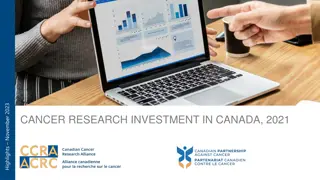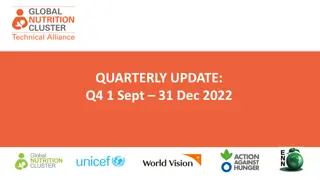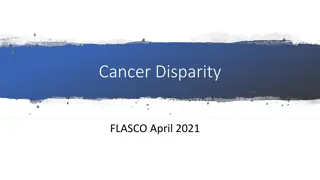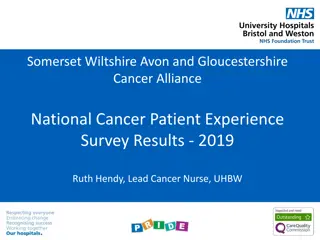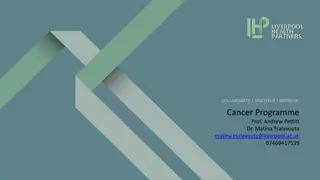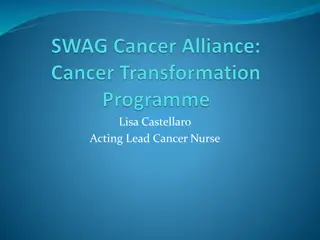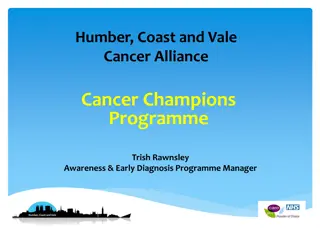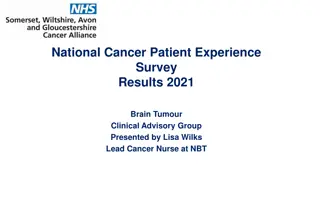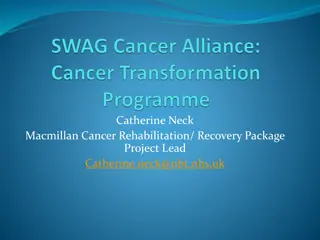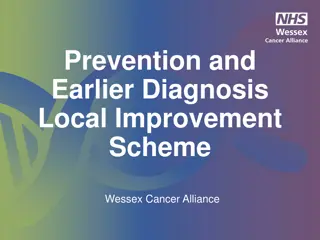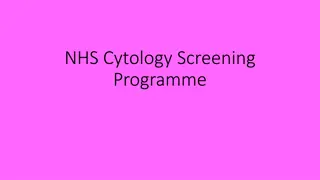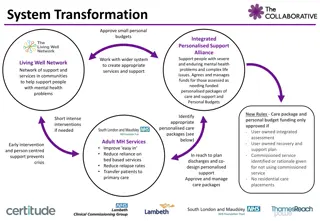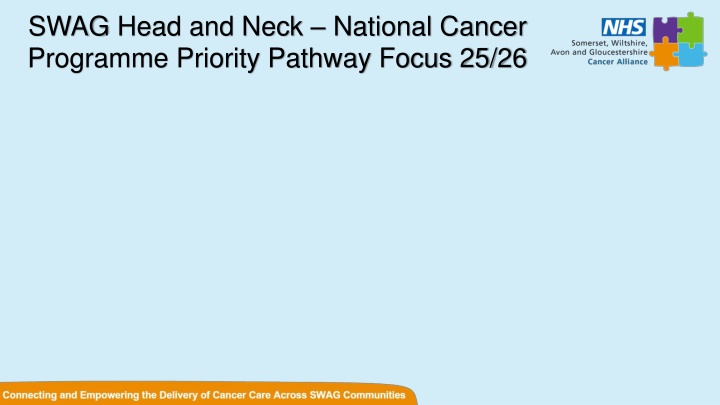
Head and Neck Cancer Program: Priority Pathways & Implementation Review
Discover the latest updates on the SWAG Head and Neck National Cancer Programme, focusing on priority pathways and the implementation status. Learn about key steps, timelines, and requirements for efficient patient care.
Download Presentation

Please find below an Image/Link to download the presentation.
The content on the website is provided AS IS for your information and personal use only. It may not be sold, licensed, or shared on other websites without obtaining consent from the author. If you encounter any issues during the download, it is possible that the publisher has removed the file from their server.
You are allowed to download the files provided on this website for personal or commercial use, subject to the condition that they are used lawfully. All files are the property of their respective owners.
The content on the website is provided AS IS for your information and personal use only. It may not be sold, licensed, or shared on other websites without obtaining consent from the author.
E N D
Presentation Transcript
SWAG Head and Neck National Cancer Programme Priority Pathway Focus 25/26
SWAG H&N 22/23 BPTP implementation https://www.england.nhs.uk/wp-content/uploads/2018/04/B1130-head- and-neck-cancer-implementing-a-timed-diagnostic-pathway-07-06-2024.pdf
SWAG H&N 22/23 BPTP implementation status UHBW GHFT SDH SFT Answer Answer Answer Answer Day Pathway Step Question (select from drop down) (select from drop down) (select from drop down) (select from drop down) Does the local referral pathway include a minimum dataset (MDS)? Yes Yes Yes Yes GP and GDP referral and locally agreed minimum dataset GP Referral -3 - 0 Patient information resources co-developed with patients Do patient information resources exist in primary care for suspected colorectal cancer pathways? Yes No Yes Who delivers clinical triage of suspected H&N cancer referrals? Other clinical team member Consultant Consultant By day 3Clinically led triage and local protocols need to be in place to reduce delays Clinical Triage Patient information provided in consultation or OPA/Clinic Yes Yes Yes Partial Is straight to one-stop available for eligible patients? Is an outpatient appointment offered to patients not eligible for one-stop? No Yes Partial Yes By day 10Straight to one-stop clinic provision for all eligible patients One-Stop Yes Yes Yes Yes Histopathology results taken during procedures should be reported within 7 calendar days Histopathology reported within 7 days ? Partial Partial No Partial Dedicated CT/MRI slots available? No No No No CT / MRI dedicated all tumour cancer slots from clinical triage, and/or follow-up from one-stop clinic investigations MRIs conducted within 7 calendar days of biopsies No No No Yes Scans/tests By day 20 MRI/CT reported within 5 Calendar days Partial No Yes Partial PET-CT scan, if required, should be carried out (to nationally agreed service specifications) and reported within 10 calendar days of request MDT for review and planning of potential treatment options, with alternative treatment options pre-agreed based on potential outcome of further tests PET-CT reported within 10 calendar days? Partial no No No Are all patients discussed at MDT to confirm treatment plan? Yes Yes Yes Yes MDT By day 28 Are alternative treatment options pre-agreed based on outcome of further tests? Are patients informed of their diagnosis within 28 days? Yes Yes Yes Yes Yes Yes Partial Yes Treatment options discussed at multi- disciplinary outpatient clinic
SWAG H&N 22/23 BPTP implementation UHBW GHFT SDH SFT Answer Answer Answer Answer Day Pathway Step Question (select from drop down) (select from drop down) (select from drop down) (select from drop down) Pathway Navigator in post? Yes Yes Yes Yes Pathway Navigation. Patients should be supported through their pathway via (as far as possible) a single point of contact with SMS/email appointment reminders. This may be delivered through Pathway Navigator roles or from existing members of the care team, with the approach tailored to suit the pathway. The role may include coordination of appointments and providing information/guidance about each part of the diagnostic process, as well as an overall timeline to patients and carers. They help to ensure there is a robust handover of patients to onward care services and support them to access additional services during and immediately after their diagnosis. The Pathway Navigator role provides additional opportunities to link people with community support and third sector services including psychosocial resources and ensure that patients accessibility needs are considered throughout their care. If Pathway Navigator in post is this Permanent/fixed term (if FT when is the end date) Fixed term Head and neck patients pre-diagnosis are supported by the fast track/MDT coordination team - they are given a number by GP as part of the referral process. They can then call with any questions about their pathway and appointments. There has not been much take up of this by patients. Yes Permanent The Pathway navigator role is part of a larger coordinater role. The pathway navigator elements include chasing up the booking of investigations and actioning of results. This role is a combination of administration, clinic organisation, clinical team and patient support. Permanent Navigator works closely with CNS Team to contact patients and book in patients for diagnostics including scopes and scans. Navigator tracks patients at teritary centres for treatment and chases updates. Fixed Term Please describe the approach for pathway navigation within your trust? Navigator is involved from when the patient has an X-ray and goes on to have a CT scan, they are also present in OPA and also support with the any follow up. They work closely with the CNSs to support patients through the pathway and also chasing pathology reports. Yes Pathway Navigators Are you evaluating the role of the navigator to inform a business case for sustaining? No Have Patient evaluations been conducted? No No No
SWAG H&N: CAG Work Under consideration/ way UHBW head and neck service has seen a 13% increase in urgent suspected cancer referrals since April compared to the same period last year. The conversion rate is 2.6% and most patients are discharged at first appointment. Propose model trial aimed to reducing waiting times, improving patient experience, and reducing the number of tests requested unnecessarily. The model uses risk-stratified triage, telephone appointments, and consultant supervision of multiple ANP/resident doctor streams. Two consultant leads, one ENT, one OMFS. 238,254 to fund the project for one year. That is to employ 1 WTE specialist doctor, 1.5 WTE ANPs, and 0.5 WTE specialist dentist. These roles will sit across both our OMFS and ENT teams. H&N Institute Proposal Bristol and Bath ?SWAG wide approach Two-Week Wait Referrals: Neck Lump Service change post centralisation and Thyroid Cancer Pathway for NBT/UHBW Patient experience work Sentinel lymph node biopsy for H&N cancer patients as per NICE Guidance Low risk thyroid MDT triage / reform Panendoscopy QI project RUH access to dentistry / digital intra-oral scanner rental Robotic surgery PET CT at BRI: Area identified, and initial plan being drawn up, very early days
SWAG Urology: National Cancer Programme 25/26 Priority pathway deliverables: Improvement plans for tumour sites where FDS H&N below 75% and where H&N 62d performance is in the bottom quartile or under 50% in Q2 Ensure funding delivers genuine additionality specifically to add diagnostic capacity and address 31-day surgical performance where >25% of patients are waiting more than 31 days Deliver targeted interventions for Suspected H&N Cancer by Q4 potentially including review of best practice, streamlining dental referrals, implementing risk stratification tools and improving information for high-risk populations. Clear triage and safety netting Review and plan to address the variation in cancer vs non-cancer FDS performance Pilot endoscope-i, telescopic referral pathway for identified low performing (>75% FDS) services by Q4. Explore benefits of lumps and bumps clinics to inform further rollout Establish the model and baseline one-stop clinics (either ENT, OMF, or neck)
SWAG H&N FDS Cancer diagnosed Cancer ruled out
SWAG H&N 62 day 75.4% 63% 77.3% 59.2% 46.7%
SWAG H&N Summary ? Opportunities for SWAG supported CAG directed work Re-baseline re BPTP and GIRFT recommendations, with cancer/non cancer review SWAG wide institute and network digital image sharing framework procurement complete Restorative dentistry Risk stratification, triage and safety netting Patient information Telescopic referral pathway


